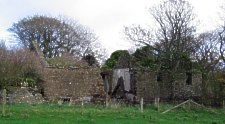
Today's roofless ruin

Today's roofless ruin
This had a life of some 12 years before running foul of an interpretation of the Westminster Parliament Act which allowed duty free import of Articles into the UK which were the produce (or manufactured there from) of the Isle of Man - as Cotton was not considered to fall into this category the imposed duties made the mill uneconomic.
The story of the Mill is well told by Aspin - the enterprise started in 1780 when Deeemster Thomas Moore offered to build a water powered mill on his estate and then to rent it to Abraham De La Pryme (Merchant) and Francis Wheelhouse (watchmaker) both then of Sheffield. The 34 ft long, 26ft wide three storey building built a little downstream of Rushen Abbey on the Silverburn probably housed six frames with a total of 288 spindles. Abraham (1758-1825) and his twin brother Francis (1758-1803) moved to the Island where Abraham married Elizabeth Wheelhouse (daughter of Francis) in 1783 ; a daughter Mary was baptised in 1790. Cotton Twist was being produced by late 1782 as the Manchester Mercury of 5 November 1782 reports the arrival of "1 case of cotton yarn" - such exports apparently continued without any probem until 1791 when the Liverpool Customs officers began to apply a stricter interpretation of the 1765 act and detained the cotton until duty had been paid.
Abraham successfully engaged the support of Governor Shaw as well as the sympathy of the Liverpool Customs officers who pointed out that cotton could be freely imported from Ireland and that encouragement of trade in the Island would help reduced the smuggling - however the support was insufficient to get the duty removed and the mill folded c. 1794.
The link between Abraham and the Island may well have been via Blackburn - a older brother, James (1755-1828), had settled in Blackburn in the 1770's as a cotton manufacturer and merchant and another Blackburn family, the Grimshawe's, had managed a dyeing and printing works at Port-e-chree from c.1770. The financial backing for this enterprise was given by John Quayle CR and John Taubman. The Grimshawe brothers, sons of Nicholar Grimshawe who had moved from being a woollen draper to manufacturer of cotton greys were John, manager of works, William, a dyer, and Nicholas jnr who introduced jenny spinning into the renovated mills, another brother Thomas ran a shop in Douglas. Locally woven cloth as well as imported material from Blackburn was made into garments and handkerchiefs. (This business too failed c. 1784 and Nicholas moved to Belfast). Francis Wheelhouse had entered in 1778 into an agreement with James Kenyon (also a Sheffield watchmaker) and Johnathan Moore, a Sheffield victualler, to establish a spinning mill on the Isle of Bute but pulled out leaving Kenyon to continue alone, Wheelhouse presumeably employing his capital in the Ballasalla mill.
Feltham notes in 1797/8 that it was no longer operational but that experiments were being made to turn it into a net-making factory; by 1848 it would appear to be a flax mill as mentioned by Cumming.
C Aspin The Water Spinners Helmshore Local History Society 2003 (ISBN 0 906881 11 0)
[IAIoM]T.A.Bawden, L.S. Garrad, et al The Industrial Archaeology of the Isle of Man Newton Abbot: David & Charles 1972 (ISBN 0-7153-5440-X)
|
|
||
| Water powered mills | ||
|
|
||
|
Any comments, errors or omissions
gratefully received The
Editor |
||